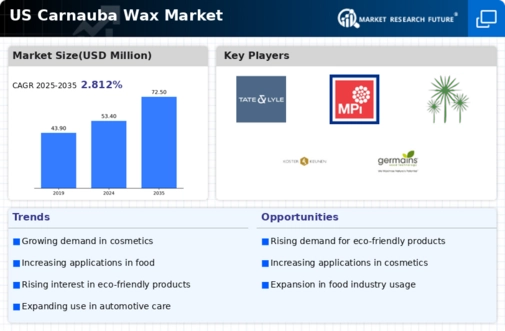Rising Demand in Cosmetics
The carnauba wax market is experiencing a notable surge in demand within the cosmetics sector. This natural wax is increasingly favored for its emollient properties, which enhance the texture and longevity of cosmetic products. In 2025, the cosmetics industry in the US is projected to reach approximately $90 billion, with a growing inclination towards natural ingredients. Carnauba wax, being a plant-derived product, aligns with consumer preferences for clean beauty. This trend is likely to bolster the carnauba wax market, as manufacturers seek to incorporate sustainable and effective ingredients into their formulations. The increasing awareness of the benefits of natural waxes in cosmetics suggests a promising trajectory for the carnauba wax market, potentially leading to a market growth rate of around 5% annually over the next few years.
Growth in Automotive Sector
The automotive sector is emerging as a key driver for the carnauba wax market. Carnauba wax is widely used in automotive care products, such as polishes and waxes, due to its ability to provide a high-gloss finish and protection against environmental factors. The US automotive market is projected to reach $1 trillion by 2025, with a growing emphasis on vehicle maintenance and aesthetics. As consumers increasingly invest in vehicle care, the demand for high-quality carnauba wax products is likely to rise. This trend suggests a potential growth rate of around 6% for the carnauba wax market, as manufacturers innovate to meet the needs of discerning automotive consumers seeking premium products.
Expansion in Food Industry Applications
The carnauba wax market is witnessing expansion due to its versatile applications in the food industry. This natural wax is utilized as a coating agent for various food products, enhancing their appearance and shelf life. In 2025, the food industry in the US is expected to grow significantly, with an increasing focus on food quality and presentation. Carnauba wax is recognized for its food-grade safety, making it an attractive option for manufacturers. The demand for natural and organic food products is also on the rise, which may further drive the adoption of carnauba wax in food applications. As the food industry evolves, the carnauba wax market could see a growth rate of approximately 4% annually, reflecting the increasing integration of natural ingredients in food processing.
Increased Interest in Eco-Friendly Products
The carnauba wax market is benefiting from a heightened interest in eco-friendly products. As consumers become more environmentally conscious, there is a growing preference for natural and biodegradable materials. Carnauba wax, being a renewable resource, aligns well with this trend. In 2025, the market for eco-friendly products in the US is expected to exceed $150 billion, indicating a substantial shift towards sustainable consumption. This shift is likely to encourage manufacturers to incorporate carnauba wax into their product lines, particularly in sectors such as cosmetics, food, and automotive care. The increasing demand for eco-friendly alternatives may propel the carnauba wax market to achieve a growth rate of approximately 5% annually, reflecting the changing consumer landscape.
Technological Innovations in Extraction Processes
Technological advancements in the extraction processes of carnauba wax are poised to enhance the efficiency and quality of production. Innovations in extraction techniques may lead to higher yields and purer forms of carnauba wax, which could attract more manufacturers to utilize this natural resource. The carnauba wax market is likely to benefit from these advancements, as they may reduce production costs and improve product consistency. In 2025, the market for natural waxes is projected to grow by 4%, driven by the increasing adoption of advanced extraction technologies. This trend suggests that the carnauba wax market could see a significant uptick in demand as manufacturers seek to optimize their production processes and meet the rising consumer expectations for quality.
















Leave a Comment